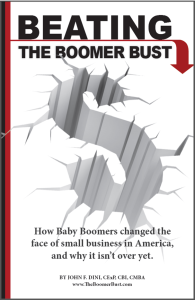Business owners live in two different worlds. If you are a Baby Boomer, the title of this column might bring memories of any one of the many covers of the song by the same name. (Everyone from Nat King Cole to Roger Williams, and from Jerry Vale to Englebert Humperdinck recorded it.)
My application of it in business refers to the chasm between those owners who plan to sell a business valued at less than $3 million, and those who have companies valued at more than that. In M&A parlance; “main street” and “mid-market” businesses.
 Some background is in order. I spent the week at two conferences. At the Business Enterprise Institute’s Exit Planners’ Conference we talk mostly about the complexities and structures of mid-market transfers. From there, I attended The Alternative Board’s International Conference for advisors who run peer advisory groups and provide coaching, principally for the owners of main street companies.
Some background is in order. I spent the week at two conferences. At the Business Enterprise Institute’s Exit Planners’ Conference we talk mostly about the complexities and structures of mid-market transfers. From there, I attended The Alternative Board’s International Conference for advisors who run peer advisory groups and provide coaching, principally for the owners of main street companies.
At the latter, I had the privilege of being on a panel with Bo Burlingham of Inc. Magazine, the author of Small Giants and Finish Big, and John Warrillow, the Founder of the Value Builder System and author of Built to Sell. It would be challenging to find three people in the country who have spent more combined time studying how small businesses sell, and what determines their value to a buyer.
the Value Builder System and author of Built to Sell. It would be challenging to find three people in the country who have spent more combined time studying how small businesses sell, and what determines their value to a buyer.
Even with two audiences of savvy professionals who are focused on the flood of business owners transitioning from their businesses, in many sessions the presenters had to explain the difference between the two markets. As an owner, it’s critical that you understand what the market is for your company. Using data from the other side of the fence is only destined to frustrate you.
Mid-Market
These are companies with a value (not revenue!) of greater than $3,000,000. To garner the interests of financial buyers (private equity groups), they have to generate pre-tax earnings of at least a million dollars a year. To attract strategic buyers, they must have some real differentiation in their industry or market. Those who are truly scalable and have already grown to over 100 employees are the hottest commodity; but according to Doug Tatum, the author of No Man’s Land, they presently account for about 30,000 of the 6.5 million private employers (2-500 employees) in the marketplace.
The acquisition outlook for these companies is wonderful. The financial market is blazing hot, with 7,000 private equity players and publicly traded acquirers chasing those 30,000 businesses, or at least any among them who will still take a phone call. Valuations are growing quickly, with multiples in the upper end of the market up over 20% in the last two years, and well over a trillion dollars of “dry powder” waiting to be spent on buying them.
Main Street
Clearly, the odds are pretty high that you are one of the 6,470,000 owners whose company does not fit the description above. Welcome to Main Street, where differentiation is difficult or impossible to quantify. (Sorry, but in all but the rarest cases, “service” is not a competitive differentiation.) The business exists primarily for the purpose of providing financial security for the owner and the employees. Likely acquirers include individuals seeking to purchase an income, small competitors, or if you are close to the million dollar pre-tax mark, perhaps a private equity group looking for a “tuck-in” or “bolt-on” to an existing similar acquisition.
The news for these owners could not be more starkly different than for the chosen few in the mid-market. According to Burlingham, somewhere between 1.3 and 2 million of these businesses will come up for sale in the coming decade. According to both IBBA (the business broker’s association) and the US Chamber of Commerce, only about 20% of them will successfully sell to a third party. With the much lower population of Generation X, who have little in the way of liquid savings and eschew 50 hour work weeks, the pre-tax multiples in Main Street values are contracting, and the shrinkage grows worse the farther down the food chain you are.
The message is clear. As John Warrillow said, if you are anywhere close to the magic numbers that attract mid-market buyers, the most important thing you can do is drive your company over the top. The difference can mean double, or even triple the proceeds you receive. Here’s an exercise. A company making $700,000 a year with a valuation of 3x earnings can sell for $2,100,000. If they grow to $1,100,000 in profits with a value of 5x earnings they’d get $5,500,000 at sale. That’s 57% growth in profits for 161% growth in price.
Any questions?
Even the measurement of earnings between the two types of business is different. We’ll discuss that next week.




